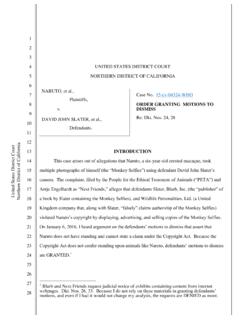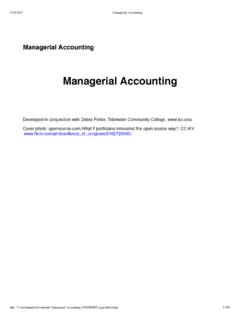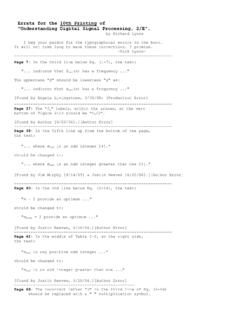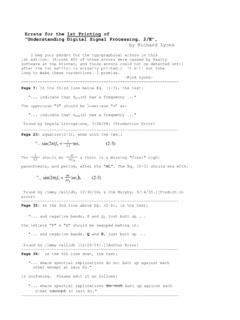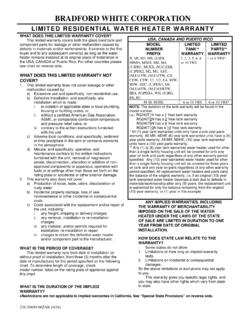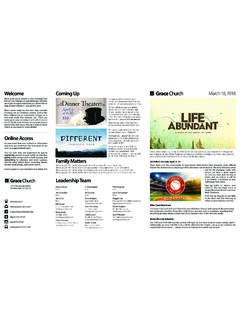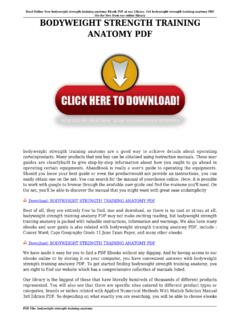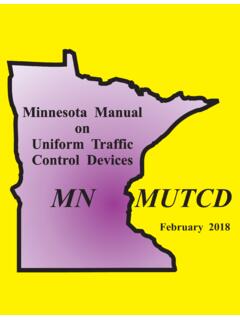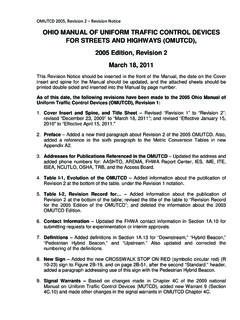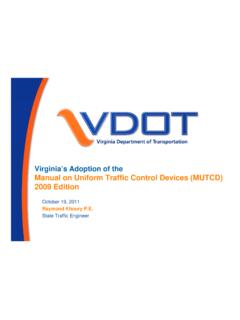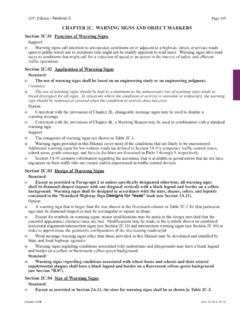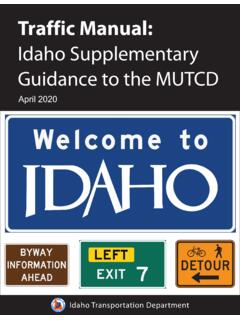Transcription of Manual on Uniform Traffic Control Devices I (MUTCD)
1 A SunCam online continuing education course Manual on Uniform Traffic Control Devices I (MUTCD) by Gregory J. Taylor, Manual on Uniform Traffic Control Devices I A SunCam online continuing education course Copyright 2012 Gregory J. Taylor, 2 of 48 PART 1 General INTRODUCTION This course discusses how to use the Manual on Uniform Traffic Control Devices for Streets and Highways (MUTCD) for establishing roadway Traffic Control . The contents of this course are intended to serve as guidance and not as an absolute standard or rule. It is intended to help you to use the MUTCD more effectively and not replace it. Should there be any conflicts between the contents of this course and the MUTCD, always follow the MUTCD. Upon course completion, you should be familiar with the general MUTCD guidelines for Traffic Control Devices .
2 The overall course objective is to give engineers and designers an in-depth look at the principles to be considered when selecting and designing for Traffic Control . For this course, the Manual on Uniform Traffic Control Devices for Streets and Highways (MUTCD) 2009 Edition will serve as the text for the fundamental design principles of Traffic signs and pavement markings. This document is recognized as the national standard for all Traffic Control Devices installed on any street, highway, bikeway, or private road open to public travel. Manual on Uniform Traffic Control Devices I A SunCam online continuing education course Copyright 2012 Gregory J. Taylor, 3 of 48 Any Traffic Control device design or application contained within the MUTCD is considered to be in the public domain and available for use. Traffic signs and pavement markings are the primary communication Devices used to inform the roadway user of laws and regulations, Traffic and roadway conditions, and guidance and other information.
3 When used properly, these critical tools provide important information to help users to safely travel on any roadway system. However, Traffic Control Devices cannot cure all Traffic problems. Drivers process different types of visual and non-visual information: speed, roadway conditions, Traffic , legal enforcement, noise levels, etc. Also, signs and markings serve as reminders of important information, so road users do not have to memorize everything. Providing drivers with relevant information when they need it, can make roads safer, more efficient, while reducing liability risks. On the other hand, poor sign management and maintenance can greatly reduce Traffic safety and contribute to roadway incidents, thereby increasing liability exposure. The Standard Highway Signs and Markings book contains detailed specifications for all adopted standard signs and pavement markings.
4 All Traffic Control Devices shall be similar to or mirror images of those shown in this Manual . Any symbols or colors cannot be modified unless otherwise stated. Manual on Uniform Traffic Control Devices I A SunCam online continuing education course Copyright 2012 Gregory J. Taylor, 4 of 48 Manual ON Uniform Traffic Control Devices (MUTCD) By law (23 CFR 655, Subpart F), the Manual on Uniform Traffic Control Devices (MUTCD) is recognized as the national standard for all Traffic Control Devices installed on any street, highway, bikeway, or private road open to public travel . It is the definitive authority for Traffic signs and pavement markings. Nationwide consistency is the goal of the MUTCD. Its intent is to enhance road safety and operation by requiring Uniform , understandable, and effective Traffic Control Devices on all facilities open to public travel.
5 The MUTCD allows us to drive anywhere in the using the same basic signs. Drivers who see a particular sign should expect it to mean the same thing and be prepared to take the same action regardless of location. The MUTCD is published by the Federal Highway Administration (FHWA) to promote safety and efficiency on our public roads by establishing Uniform standards for Traffic Control Devices . It defines the nationwide standards for the installation and maintenance of the Devices on all streets and highways. Roadway safety can many times be increased by exceeding MUTCD requirements. Oversized signs can be used where speed, volume or other factors produce conditions needing additional visibility. Any excessive practice should only be used if a standard Manual on Uniform Traffic Control Devices I A SunCam online continuing education course Copyright 2012 Gregory J.
6 Taylor, 5 of 48 measure cannot meet the need. Otherwise, road users may disregard the Traffic Control device. The MUTCD has nine chapters ( Parts ): 1. General 2. Signs 3. Marking 4. Highway Traffic Signals 5. Traffic Control Devices for Low-Volume Roads 6. Temporary Traffic Control 7. Traffic Control for School Areas 8. Traffic Control for Highway-Rail Grade Crossings 9. Traffic Control for Bicycle Facilities This course will present an overview of Parts 1 through 4, please consult the MUTCD for specific details. SHALL, SHOULD, and MAY The terms shall, should, and may have specific meanings when used in the MUTCD. These words are defined as follows: SHALL Required, mandatory or specifically prohibitive practice. Statements with shall conditions are typically used as a STANDARD in the MUTCD. These items cannot be modified or compromised.
7 There is no allowance for discretion and they must be followed. SHOULD Advisory or recommended practice in typical situations. Deviation is appropriate if justified by engineering judgment or study. Statements marked as should are used for GUIDANCE in the MUTCD. MAY Permissive or optional practice without requirement or recommendation. Manual on Uniform Traffic Control Devices I A SunCam online continuing education course Copyright 2012 Gregory J. Taylor, 6 of 48 Items marked as may are typically used in OPTION statements in the MUTCD and can contain allowable modifications. SUPPORT statements do not contain the verbs shall , should , or may . These statements are for informational purposes only without any mandate, recommendation, or enforcement. The Five Basic Requirements of Traffic Control Devices In order to be effective, any Traffic Control device has to be used in the right way.
8 The MUTCD lists the following principles to be used when selecting and applying each device: 1. Fulfill a need A sign should only be installed if there is a need for warning, regulation or guide information. It is also vital to use signs that fulfill that need. If a need exists and the sign in question does not meet that need, use something else. Overusing signs can lead to disrespect and loss of emphasis value while underuse can result in persistent but correctable safety problems. 2. Command attention Standard signs are designed to be noticed and catch the attention of road users. The high-contrast color combinations were chosen due to their ability to stand out and be easy to read. Oversized signs, doubled signs, or flashing beacons can also be used to emphasize the sign s message. 3. Command respect Road users are expected to willingly obey warnings and regulations that obviously fulfill a need.
9 Warning and regulatory signs that seem unneeded or unreasonable are regularly disobeyed. Good sign management and maintenance is crucial to commanding respect for Traffic Control Devices . Amateurish, homemade or damaged signs are more likely to be disregarded. Manual on Uniform Traffic Control Devices I A SunCam online continuing education course Copyright 2012 Gregory J. Taylor, 7 of 48 4. Have one simple message A sign needs to communicate its message in a way that is clear and readable. By using standard signs in the MUTCD that have been researched and evaluated by the FHWA, most drivers should understand their meanings. 5. Provide adequate time for proper response Traffic Control Devices should meet or exceed MUTCD standards so drivers have adequate time (Perception-Response Time PRT) to react. Drivers need to have the time and distance to take the appropriate action before they reach a situation.
10 If not, insufficient response time may result in roadway crashes. Traffic speed is an important factor for determining driver response time. Vehicles operating at high speeds need longer response time and more distance to react. This increased distance can be obtained by using larger signs, or by placing signs in advance of the location where the information is needed. Using the five basic requirements will help make your Traffic Control Devices more effective. Design, placement, operation, maintenance, and uniformity should be taken into consideration to maximize the ability of a device to meet these principles. However, by disregarding the five requirements, you may find that road users disregard your Traffic Control Devices . The MUTCD defines a road user as a vehicle operator, bicyclist, or pedestrian, including persons with disabilities, within the highway or on a private road open to public travel.



